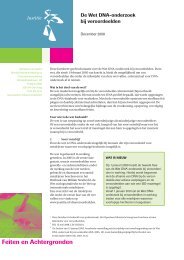INTERPOL HANDBOOK ON DNA DATA EXCHANGE AND PRACTICE
INTERPOL HANDBOOK ON DNA DATA EXCHANGE AND PRACTICE
INTERPOL HANDBOOK ON DNA DATA EXCHANGE AND PRACTICE
You also want an ePaper? Increase the reach of your titles
YUMPU automatically turns print PDFs into web optimized ePapers that Google loves.
Should <strong>DNA</strong> profiles be removed? Again, the spectrum of rules ranges from profilesnever being removed, being removed after a certain period of time, or else varying,depending on the crime, on an individual prognosis for the convicted, or on the age ofthe person. If suspects or arrestees are included in a national database, an additionalexit mechanism should be included, for example if a person is no longer a suspect or ifan accused person has been acquitted by a court, then the relevant sample is removed.Inclusion of a deletion mechanism as described will not have a negative influence on thesuccess of the database. However it may be helpful in improving the acceptance of the<strong>DNA</strong> Database by the population, as it diminishes some of the concerns held by many.In most countries restrictions regarding the inclusion of crime scene stains in nationaldatabases are set by financial limitations rather than by legislation. In most cases, thesame is true with reference samples, but wherever possible volume crimes should beincluded to increase the chance of matches with serious offences and offenders. Mostcountries keep crime scene profiles as long as they remain unsolved or when a courtorder demands their removal.The procedures for removal of profiles from the database and sample destructionneed to be defined. The authority required to order removal should be addressed.Legislation should also define who is to be allowed to take a reference sample, andon what grounds. The procedural requirements must be followed to safeguard thelegality of the sample. However, in constructing this legislation it is important not tointroduce unnecessary obstacles into the sample collection process that will impact onthe efficient collection of samples. The most efficient solution is that a police officer orappropriately trained professional should be able to take the sample and it should notbe necessary to obtain a magistrate’s or mandatory court order.Additional databases are useful and may also be ruled by legislation. This includesdatabases containing laboratory information, personal information, police eliminationprofiles, victim profiles or profiles for innocent people living near the scene of acrime or for emergency staff etc. Precautionary rules should be defined so that thesedatabases are not mixed with the criminal databases, but are only used on a case-bycasebasis. The same is true if the national <strong>DNA</strong> Database is used for identifying missingpersons or recovered unidentified bodies. Profiles obtained from family members ofmissing persons should not be mixed with the criminal database.A potentially important application of <strong>DNA</strong> profiling is through an intelligence-led massscreen. This application does not usually require use of the national <strong>DNA</strong> Database.However, a question may arise as to whether samples collected through an intelligenceledmass screen should be subsequently entered into the national <strong>DNA</strong> Database.Any national law on <strong>DNA</strong> should also include regulations on international <strong>DNA</strong> dataexchange. The <strong>INTERPOL</strong> <strong>DNA</strong> Gateway success stories show that the additionalefforts necessary for international exchange are minimal, yet the positive effect can beenormous, in terms of matches that could never have occurred otherwise.PAGE 68LEGISLATI<strong>ON</strong>







